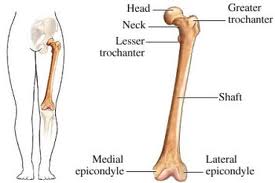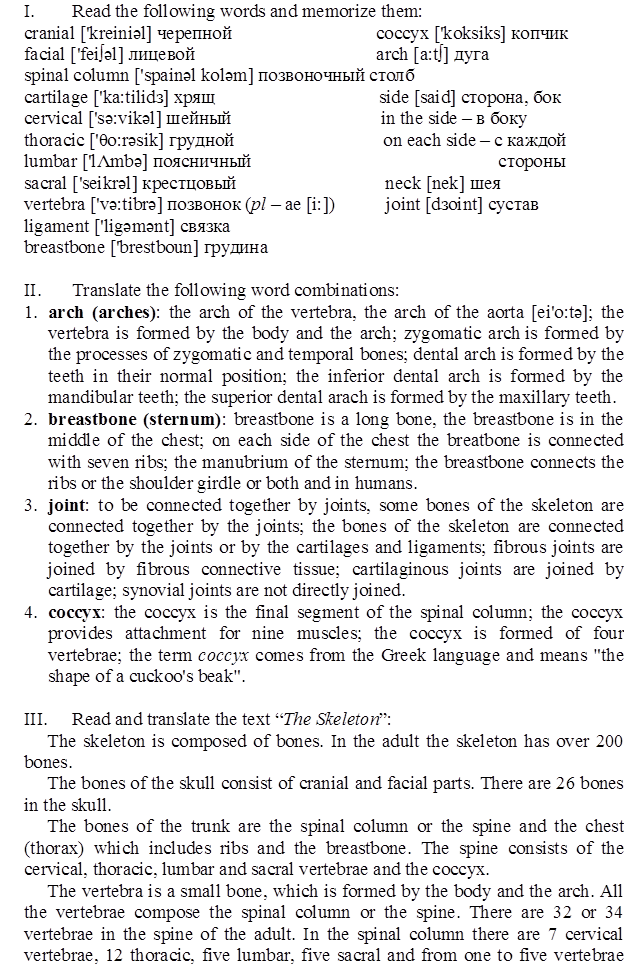
- •«Волгоградский государственный медицинский университет»
- •Кафедра иностранных языков с курсом латинского языка
- •Методические указания
- •I семестр Занятие 1(продолжительность-3ч.)
- •Занятие 2(продолжительность-3ч.)
- •Занятие 3(продолжительность-3ч.)
- •Занятие 4(продолжительность-3ч.)
- •Занятие5(продолжительность-3ч.)
- •Занятие 6(продолжительность-3ч.)
- •Занятие 7(продолжительность-3ч.)
- •Раздел2.Основной курс
- •Занятие 8(продолжительность-3ч)
- •Занятие 9 (продолжительность-3ч)
- •Занятие 10 (продолжительность-3ч)
- •Занятие 11 (продолжительность-3ч)
- •Используйте приведенные ниже клише для построения обобщенных высказываний:
- •Занятие 12 (продолжительность-3ч)
- •Занятие 13(продолжительность-3ч.) Итоговая контрольная работа по теме «Биология как наука. Формы организации жизни на Земле. Биологическое разнообразие» Занятие 14 (продолжительность-3ч)
- •Занятие 15 (продолжительность-3ч)
- •Занятие 16 (продолжительность-3ч)
- •Занятие 17 (продолжительность-3ч)
- •Занятие 18 (продолжительность-3ч)
- •Сравните Present Simple Active & Present Continuous Active
- •Занятие 2(продолжительность-2ч.)
- •Занятие 3(продолжительность-2ч.)
- •Занятие 4(продолжительность-2ч.)
- •Занятие 5(продолжительность-2ч.)
- •Занятие 6(продолжительность-2ч.)
- •Занятие 9(продолжительность-2ч.)
- •Занятие 10(продолжительность-2ч.)
- •4) Работа над грамматическим материалом:
- •Занятие 11(продолжительность-2ч.)
- •Занятие 12(продолжительность-2ч.)
- •Занятие 13(продолжительность-2ч.) Итоговая контрольная работа по теме «Микробиология как наука. Вирусология и иммунология» Занятие 14(продолжительность-2ч.)
- •Занятие 15(продолжительность-2ч.)
- •Занятие 16(продолжительность-2ч.)
- •Занятие 17(продолжительность-2ч.)
- •Занятие 18(продолжительность-2ч.)
- •Занятие 19(продолжительность-2ч.) Итоговая контрольная работа по теме «Физика. Основные законы физики. Физика в медицине»
Занятие 15 (продолжительность-3ч)
Тема: Физиология систем и органов. Основные физиологические процессы в организме человека.
Цель: развитие навыков чтения и повседневного общения, а также формирование и развитие компетенций:
-ОК-1-способность к обобщению, анализу, восприятию информации, постановке цели и выбору путей ее достижения, владение культурой мышления;
-ОК-2-способность логически верно, аргументировано и ясно строить устную и письменную речь, создавать тексты профессионального назначения;
ПК-13- способность использовать один из иностранных языков в общении и профессиональной деятельности на уровне, не ниже разговорного.
Задачи:
-Повторить временные формы страдательного залога–времена группы Simple (Indefinite);
-Тренировать навык изучающего чтения для перевода специальных текстов по теме «Физиология»;
- Освоить терминологию по теме «Физиология систем и органов».
Этапы занятия: 1) Проверка домашнего задания
2) Речевая разминка:
Ответьте на следующие вопросы:
What is the framework of the human body?
How are bones connected with each other?
What are the main bones in the trunk?
What is the longest bone in the body?(femur or thigh bone)
What is the smallest bone in the body?(stirrup bone)
Посмотрите на схему бедренной кости и расскажите по-
английски, из чего она состоит:

Shaft – is a long slender part, such as the portion of a long bone between the wider ends or extremities.
Greater trochanter – is a large, irregular, quadrilateral eminence and a part of the skeletal system.
Lesser trochanter – is a conical eminence, which varies in size in different subjects.
Epicondyle – A rounded projection at the end of a bone, located on or above a condyle and usually serving as a place of attachment for ligaments and tendons.
3) Работа над грамматическим материалом:
Задание1.Заполните пропуски соответствующим словом-наименованием частей/органов человеческого тела:
1. The ________ (lungs, blood vessels) are responsible for transporting blood throughout the body.
2. Smoking increases the risk of _______ (spine, blood vessels, lung) cancer.
3. Angela's _______ (lungs, stomach, heart) beats faster when she goes jogging.
4. ________ (Stomach, Spinal column, Lung) aches are often caused by eating too much.
5. The ________ (liver, bladder, blood vessels) produces bile that is stored in the gallbladder.
6. The heart is a muscular pump that pushes blood through _______ (bladder, liver, blood vessels) around the body.
7. I filled my _______ (lungs, heart, spine) with the clean fresh air during the walk in the woods.
8. When the ________ (liver, stomach, lung) produces too much acid it can lead to acid reflux.
9. Jerry suffered serious injuries in the accident. He broke his _______ (spinal column, bladder, stomach), ribs and right leg.
10. She broke her _______ (heart, spine, liver) in three places after falling from a horse.
Задание2. Поставьте глагол «to be» в правильную форму:
1) There … (be) twelve pairs of ribs in the human body.
2) There … (be) several important ligaments in the hip.
3) There … (be) cartilage on both sides of the sacroiliac joint surfaces.
4) There … (be) many systems in the human body.
5) There … (be) two parts to the skeletal system: the axial skeleton and the appendicular skeleton.
6) There … (be) fourteen bones in the face.
7) There … (be) 33 irregular bones called «vertebrae» in the spine but some are fused together and so these are actually 26 separate bones forming the spine.
8) There … (be) thirty-two bones in each upper limb.
9) There … (be) thirty-one bones in each lower limb.
Задание3. Соотнесите органы и системы органов в человеческом организме:
Organ |
System of organs |
|
|
|
|
|
|
|
|
|
|
Circulatory system, bones heart, large intestine, kidneys, blood, vessels, skeletal system, lungs, nose, excretory system, trachea, lungs, digestive system,
respiratory system, muscles, nervous system, male and female reproductive organs, immune system, mouth, esophagus, stomach, muscular system, reproductive system, bladder, kidneys, intestines, urinary system, endocrine system, brain, glands, spinal cord, nerves, many types of protein, cells, organs, tissues
Задание4.Переведите на английский язык:
1) Грудина представляет собой длинную плоскую кость.
2) Рукоятка грудины (manubrium of the sternum) – это широкая верхняя часть грудины.
3) Самая длинная часть грудины называется телом.
4) Наружный слой кости называется периост (periosteum).
5) Красный костный мозг (red bone marrow) находится внутри кости.
6) Сустав – это место, в котором соединяются две кости.
7) Череп состоит из 22 костей. Они соединяются между собой швами (suture).
8) Кости классифицируются на длинные и короткие.
9) В черепе человека выделяют 8 костей.
10) Все кости черепа прочно (firmly) соединяются между собой, за исключением (except) нижней челюсти (lower jaw/mandible).
Задание5.Прочтите текст и расскажите об осевом и аппендикулярном скелете. Чем они различаются?
There are two parts to the skeletal system: the axial skeleton and the appendicular skeleton. The axial skeleton has 80 bones, and is made up of the bones of the head, the ribs, and the vertebral column. The appendicular skeleton has 126 bones and includes the bones of the upper and lower limbs and the pelvic and pectoral girdles. The appendicular skeleton's function is to make locomotion possible and to protect the body's major internal organs (aside from those protected by the axial skeleton).
4) Информативное чтение «The skeleton»:

which form the coccyx. The lumbar vertebrae are the largest in the spinal column. They have oval bodies.
The chest (thorax) is composed of 12 thoracic vertebrae, the breastbone and 12 pairs of ribs. The breastbone is a long bone in the middle of the chest. It is composed of three main parts. The basic part of the chest is formed by the ribs. On each side of the chest 7 ribs are connected with the breastbone by cartilages. The cartilages of 3 other ribs are connected with each other and with the 7th rib. But the cartilages of these ribs are not connected with the breastbone. The 11th and 12th ribs are not connected with the breastbone either. They are not connected with other ribs, they are free. Each rib is composed of a head, neck and body.
The bones of the skeleton are connected together by the joints or by the cartilages and ligaments.
Задание1. Заполните пропуски соответствующей формой глагола, данного в скобках в Passive или Active залоге:
1) The human skeleton ... (to compose of) more than 200 bones.
2) The skeleton also ... (to contain) cartilages.
3) Ligaments ... (to be) strong strips of fibrous connective tissue that hold bones together at joints.
4) The human skull ... (to protect) the brain, and ... (to protect) special sense organs of taste, smell, hearing, vision, and balance.
5) The human skull ... (to form) from 26 bones, 21 of which are locked together by immovable joints.
6) The skull ... (to subdivide) into 2 parts, namely: cranial and facial bones.
7) The 8 bones of the cranium ... (to support, surround, protect) the brain within the cranial cavity.
8) The ribs ... (to be) curved, flat bones with a slightly twisted shaft (ствол, диафиз, стержневидная структура).
9) The 12 pairs of ribs ... (to form) a ribcage that protects the heart, lungs, major blood vessels, stomach, and liver.
10) The pelvis ... (to be) the bony structure located at the base of the spine.
11) The pelvis ... (to form) the lower limb girdle of the skeleton.
12) The 12 thoracic vertebrae ... (to compose) the middle segment of the vertebral column, between the cervical vertebrae and the lumbar vertebrae.
Задание2. Заполните пропуски соответствующими глаголами:
1. The human skeleton _________ 206 bones. 2. These bones ________ your body and ________you to move. 3. Bones _________a lot of calcium (an element found in milk, broccoli, and other foods). 4. The longest bone in our bodies _______the femur (thigh bone). 5. The smallest bone ________ the stirrup bone inside the ear. 6. Each hand ________26 bones in it. 7. Your nose and ears ______not ______ bone; they ________a cartilage, which is a flexible substance that is not as hard as bone. 8. Bones _________to other bones at joints. 9. There _______ many different types of joints, including: fixed joints, hinged joints, and ball-and-socket joints. 10. Fixed joints which, _________ in the skull, __________ many bones. Hinged joints _________ in the fingers and toes. 11. Ball-and-socket joints ________ in the shoulders and hips.
Задание3. Расскажите о строении позвоночника в теле человека. Используйте следующую схему:

Интерактивная форма работы – тренинг. Студенты должны назвать как можно больше терминов-обозначений костей и составных частей скелета человека. Если студент затрудняется назвать термин, когда подходит его очередь, он прекращает свое участие в тренинге.
